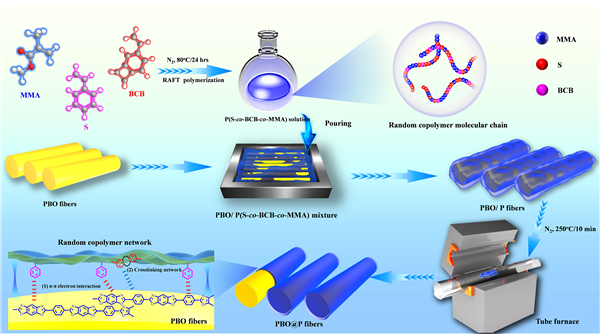Lin Tang, Junliang Zhang and Junwei Gu*. Random copolymer membrane coated PBO fibers with significantly improved interfacial adhesion for PBO fibers/cyanate ester composites. Chinese Journal of Aeronautics, 2021, 34(2): 659-668. 2019IF=2.215.(2区工程技术期刊,中国科技期刊卓越行动计划-领军期刊类项目)
(https://doi.org/10.1016/j.cja.2020.03.007)
AbstractPoly(p-phenylene-2,6-benzobisoxazole) (PBO) fibers possess excellent dielectric, mechanical properties and heat resistance. However, the surface of PBO fibers is smooth and highly chemical inert, resulting in poor interfacial compatibility to polymer matrix, which severely limits its wider application in high-performance fiber-reinforced resin matrix composites. In this work, random copolymers (P(S-co-BCB-co-MMA)) containing benzocyclobutene in the side-chain were synthesized by reversible addition-fragmentation chain transfer (RAFT) polymerization, which were then utilized to form dense random copolymer membrane on the surface of PBO fibers by thermally cross-linking at 250oC (PBO@P fibers). Four kinds of synthesized P(S-co-BCB-co-MMA) with different number-average molar mass (Mn) were well controlled and possessed narrow dispersity. When the Mn was 32300, the surface roughness of PBO@P fibers was increased from 11 nm (PBO fibers) to 39 nm. In addition, PBO@P fibers presented the optimal interfacial compatibility with bisphenol A cyanate (BADCy) resins. And the single fiber pull-out strength of PBO@P fibers/BADCy micro-composites was 4.5 MPa, increasing by 45.2% in comparison with that of PBO fibers/BADCy micro-composites (3.1 MPa). Meantime, PBO@P fibers still retained excellent tensile strength (about 5.1 GPa). Overall, this work illustrates a simple and efficient surface functionalization method, which would provide a strong theoretical basis and technical support for controlling the surface structure & chemistry of inert substrates.
聚对苯撑苯并二噁唑(PBO)纤维具有优异的介电性能、力学性能和耐热性能,然而其表面光滑且呈极强的化学惰性,与树脂基体相容性极差,严重限制了其在高性能纤维增强树脂基复合材料领域更广的应用。本文采用可逆加成-断裂链转移(RAFT)聚合合成一种侧链含有苯并环丁烯的无规共聚物P(S-co-BCB-co-MMA),经热交联在PBO纤维表面形成一层致密的无规共聚物膜(PBO@P纤维)。结果表明,经RAFT聚合得到可控的无规共聚物P(S-co-BCB-co-MMA)具有窄的多分散系数,且通过热交联(250oC)在PBO纤维表面形成一层无规共聚物膜。当P(S-co-BCB-co-MMA)的分子量(Mn)为32300时,PBO@P纤维的表面粗糙度从11 nm(PBO纤维)提高到39 nm,与双酚A型氰酸酯(BADCy)树脂的界面相容性最佳。且PBO@P纤维/BADCy树脂微复合材料的单丝拔出强度为4.5 MPa,较PBO纤维/BADCy树脂微复合材料的单丝拔出强度(3.1 MPa)提高了45.2%。同时,PBO@P纤维仍保留PBO纤维优异的拉伸强度(5.1 GPa)。此外,本文采用简单、高效的表面改性技术为调控惰性基质表面结构和表面化学提供强有力的理论依据和技术支撑。
